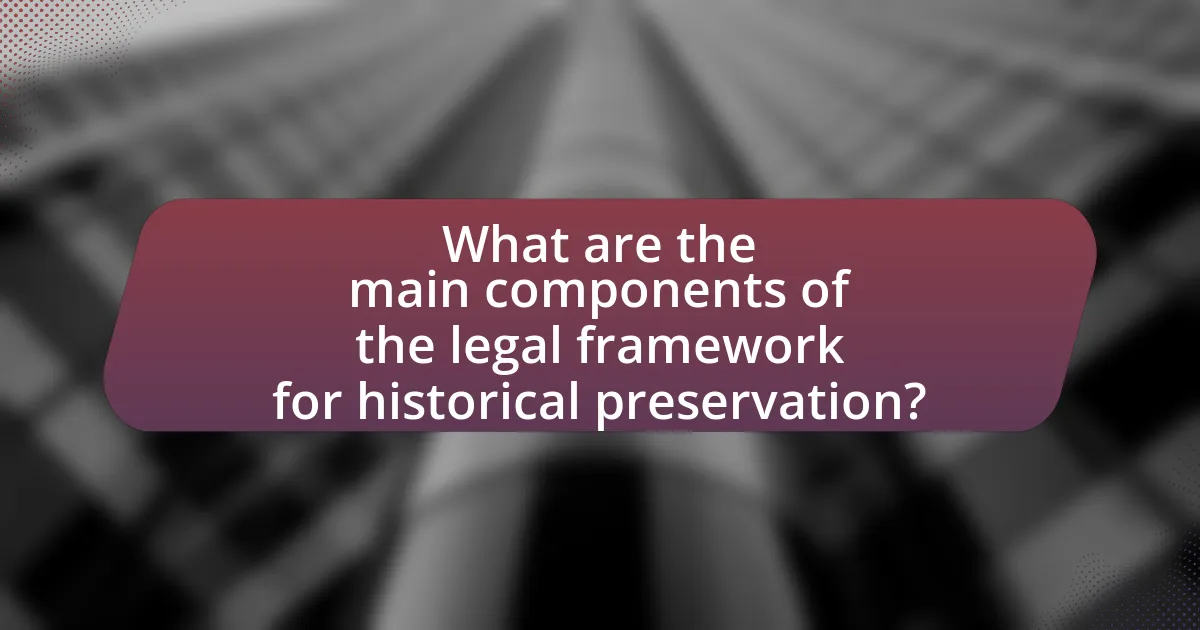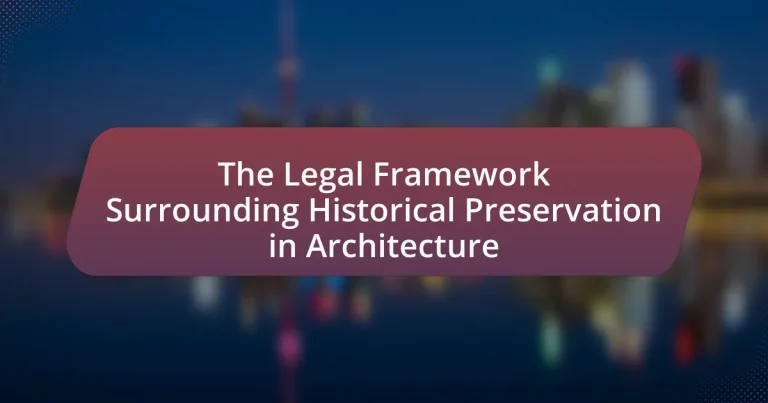The legal framework surrounding historical preservation in architecture encompasses federal, state, and local laws designed to protect culturally significant structures. Key legislation, such as the National Historic Preservation Act of 1966, establishes guidelines for identifying and preserving historic properties, while state and local regulations provide additional protections and incentives for restoration efforts. This framework not only safeguards architectural heritage but also addresses the balance between individual property rights and public interest in maintaining historical integrity. The article further explores the implications of these laws, the challenges faced in preservation efforts, and the role of community engagement in advocating for stronger preservation policies.

What is the Legal Framework Surrounding Historical Preservation in Architecture?
The legal framework surrounding historical preservation in architecture primarily consists of federal, state, and local laws aimed at protecting culturally significant structures. The National Historic Preservation Act of 1966 established a national policy for preserving historical sites and created the National Register of Historic Places, which identifies and protects significant properties. Additionally, state laws often complement federal regulations by providing specific guidelines for preservation efforts, such as tax incentives for restoration and grants for maintenance. Local ordinances may also impose restrictions on alterations to designated historic buildings, ensuring their architectural integrity is maintained. These laws collectively aim to safeguard architectural heritage while balancing development needs.
How does the legal framework impact historical preservation efforts?
The legal framework significantly impacts historical preservation efforts by establishing regulations and guidelines that protect cultural heritage sites. These laws, such as the National Historic Preservation Act in the United States, provide a structured process for identifying, evaluating, and protecting historic properties, ensuring that they are preserved for future generations. Additionally, legal frameworks often include incentives, such as tax credits and grants, which encourage property owners to maintain and restore historic structures. For instance, the federal tax incentive program has facilitated the rehabilitation of thousands of historic buildings, demonstrating the effectiveness of legal measures in promoting preservation.
What are the key laws and regulations governing historical preservation?
The key laws and regulations governing historical preservation include the National Historic Preservation Act of 1966, which established a framework for preserving historical sites in the United States. This act created the National Register of Historic Places, which identifies and protects significant historical and archaeological sites. Additionally, the Secretary of the Interior’s Standards for the Treatment of Historic Properties provide guidelines for the preservation, rehabilitation, restoration, and reconstruction of historic buildings. Local preservation ordinances and zoning laws also play a crucial role in protecting historical sites at the municipal level, ensuring that alterations and demolitions are regulated to maintain historical integrity.
How do these laws vary by region or country?
Laws surrounding historical preservation in architecture vary significantly by region and country, reflecting local cultural values, historical contexts, and governance structures. For instance, in the United States, the National Historic Preservation Act of 1966 establishes a framework for preserving historical sites, while individual states may have their own regulations that can be more stringent. In contrast, European countries like Italy and France have comprehensive national laws that prioritize the preservation of cultural heritage, often requiring extensive documentation and approval processes for any alterations to historical buildings. Additionally, countries such as Japan incorporate traditional practices into their preservation laws, emphasizing the importance of maintaining cultural identity. These variations are influenced by factors such as the level of industrialization, historical events, and public awareness of heritage conservation, demonstrating that legal frameworks are tailored to the unique needs and priorities of each region or country.
Why is historical preservation important in architecture?
Historical preservation is important in architecture because it safeguards cultural heritage and promotes community identity. By maintaining historical structures, societies can retain their unique architectural styles and historical narratives, which contribute to a sense of place and continuity. For instance, the preservation of buildings like the Colosseum in Rome or the Eiffel Tower in Paris not only honors the craftsmanship of past eras but also attracts millions of tourists, thereby boosting local economies. Furthermore, studies show that preserved historic districts can enhance property values and foster community pride, as seen in cities like Charleston, South Carolina, where preservation efforts have led to increased tourism and economic revitalization.
What cultural and historical values are preserved through architecture?
Architecture preserves cultural and historical values by embodying the artistic, social, and technological achievements of a society. For instance, structures like the Parthenon in Greece reflect ancient democratic ideals and religious practices, while Gothic cathedrals in Europe showcase advancements in engineering and artistry during the Middle Ages. These buildings serve as tangible links to the past, illustrating the values, beliefs, and lifestyles of the people who created them. Furthermore, preservation laws, such as the National Historic Preservation Act in the United States, protect these architectural treasures, ensuring that future generations can appreciate and learn from their historical significance.
How does historical preservation contribute to community identity?
Historical preservation contributes to community identity by maintaining and showcasing the unique architectural and cultural heritage of a community. This preservation fosters a sense of belonging and continuity among residents, as it allows them to connect with their history and shared experiences. For example, communities that preserve historic buildings often see increased local pride and engagement, as these structures serve as tangible reminders of their past. Studies have shown that areas with preserved historical sites experience higher levels of community involvement and tourism, which further reinforces the local identity.

What are the main components of the legal framework for historical preservation?
The main components of the legal framework for historical preservation include federal laws, state laws, local ordinances, and guidelines established by preservation organizations. Federal laws, such as the National Historic Preservation Act of 1966, provide a national policy for the preservation of historical sites and establish the National Register of Historic Places. State laws often mirror federal regulations and may include specific provisions for state-owned properties. Local ordinances typically regulate zoning and land use, ensuring that historical districts maintain their character. Additionally, guidelines from organizations like the National Park Service offer standards for preservation practices, ensuring consistency and quality in preservation efforts.
What types of legal protections exist for historical buildings?
Legal protections for historical buildings include federal, state, and local designations that safeguard their integrity and heritage. The National Historic Preservation Act (NHPA) of 1966 establishes a framework for preserving historical sites in the United States, allowing for the listing of properties on the National Register of Historic Places, which provides access to federal tax incentives and grants. Additionally, state historic preservation laws often mirror federal protections, enabling states to designate local landmarks and enforce preservation ordinances. Local governments may also implement zoning laws and building codes specifically aimed at protecting historical structures, ensuring that any alterations or demolitions undergo review processes to maintain their historical significance. These legal frameworks collectively aim to preserve the cultural and architectural heritage of communities.
How do landmark designations affect property rights?
Landmark designations significantly restrict property rights by imposing regulations that limit alterations, demolitions, and developments on designated properties. These designations are intended to preserve historical, architectural, or cultural significance, which often results in property owners needing to seek approval for any changes, thereby reducing their autonomy over the property. For example, in the United States, the National Historic Preservation Act of 1966 established a framework that allows local, state, and federal governments to designate landmarks, which can lead to restrictions on property use and modifications. This legal framework underscores the balance between individual property rights and the public interest in preserving cultural heritage.
What role do preservation easements play in protecting historical sites?
Preservation easements play a critical role in protecting historical sites by legally restricting alterations to the property that could compromise its historical integrity. These easements are voluntary agreements between property owners and preservation organizations, ensuring that the historical features of the site are maintained and preserved for future generations. For example, the National Trust for Historic Preservation utilizes preservation easements to safeguard significant properties across the United States, demonstrating their effectiveness in maintaining the character and historical significance of these sites.
How do federal, state, and local laws interact in preservation efforts?
Federal, state, and local laws interact in preservation efforts through a hierarchical framework where federal laws set baseline standards, state laws provide additional protections, and local laws implement specific regulations tailored to community needs. The National Historic Preservation Act of 1966 establishes federal guidelines for preserving historical sites, while state historic preservation offices enhance these efforts by administering programs and funding at the state level. Local governments often enact zoning laws and ordinances that directly affect preservation efforts, ensuring that local historical contexts and community values are respected. This multi-tiered approach allows for comprehensive preservation strategies that address both broad national interests and specific local concerns.
What is the role of the National Historic Preservation Act?
The National Historic Preservation Act (NHPA) plays a crucial role in preserving historical and archaeological sites in the United States. Enacted in 1966, the NHPA established a framework for the protection of significant cultural resources by promoting the identification, evaluation, and protection of historic properties. The Act created the National Register of Historic Places, which recognizes and protects sites of historical significance, and mandates federal agencies to consider the impact of their projects on these properties. This legal framework ensures that cultural heritage is preserved for future generations, reflecting the nation’s history and diversity.
How do local ordinances complement federal and state laws?
Local ordinances complement federal and state laws by providing specific regulations that address community needs and local conditions. These ordinances can enhance broader legal frameworks by establishing guidelines for historical preservation that reflect the unique cultural and architectural heritage of a locality. For example, while federal laws like the National Historic Preservation Act set general standards for preservation, local ordinances can impose stricter criteria or additional protections tailored to the specific historical context of a community, ensuring that local values and priorities are upheld in preservation efforts. This layered approach allows for a more nuanced application of preservation laws, fostering a balance between national standards and local identity.

What challenges exist within the legal framework of historical preservation?
The legal framework of historical preservation faces several challenges, including conflicting property rights, inadequate funding, and varying levels of governmental support. Conflicting property rights arise when private owners wish to modify or demolish historically significant structures, often leading to legal disputes over preservation mandates versus individual property rights. Inadequate funding limits the ability of preservation organizations and government entities to maintain and restore historical sites, as many rely on grants and donations that may not be consistently available. Additionally, varying levels of governmental support can create inconsistencies in preservation efforts, as local, state, and federal regulations may differ significantly, complicating the enforcement of preservation laws. These challenges hinder effective historical preservation and can lead to the loss of culturally significant architecture.
What are common legal disputes related to historical preservation?
Common legal disputes related to historical preservation include conflicts over property rights, zoning regulations, and compliance with preservation laws. Property owners often contest restrictions imposed by local, state, or federal preservation statutes, arguing that these limitations infringe on their rights to modify or develop their properties. Zoning disputes arise when preservation efforts conflict with planned developments, leading to legal challenges regarding land use. Additionally, compliance issues can occur when property owners fail to adhere to guidelines set forth by preservation organizations or government agencies, resulting in legal actions aimed at enforcing these regulations. These disputes are often rooted in the balance between individual property rights and the public interest in maintaining historical integrity.
How do property owners navigate conflicts with preservation laws?
Property owners navigate conflicts with preservation laws by engaging in dialogue with local preservation authorities and seeking to understand the specific regulations that apply to their properties. This proactive approach often involves researching the historical significance of their property, which can help in negotiating modifications or exemptions. For instance, property owners may present evidence of the building’s condition or propose alternative preservation methods that align with both their interests and preservation goals. Additionally, they may seek legal counsel to explore their rights and options under the law, ensuring compliance while advocating for their property needs.
What are the implications of non-compliance with preservation regulations?
Non-compliance with preservation regulations can lead to significant legal and financial repercussions for individuals and organizations. Violators may face fines, legal action, and the potential loss of funding or tax incentives associated with preservation efforts. For instance, the National Historic Preservation Act mandates compliance, and failure to adhere can result in penalties that vary by jurisdiction, often including substantial monetary fines. Additionally, non-compliance can jeopardize the integrity of historical sites, leading to irreversible damage and loss of cultural heritage, which can diminish community value and historical significance.
How can stakeholders advocate for stronger preservation laws?
Stakeholders can advocate for stronger preservation laws by forming coalitions to amplify their voices and influence policymakers. These coalitions can engage in public awareness campaigns that highlight the cultural, economic, and environmental benefits of preservation, thereby demonstrating the importance of stronger legal protections. For instance, studies show that historic preservation can increase property values by 20% and boost local economies through tourism, which provides concrete evidence to support their advocacy efforts. Additionally, stakeholders can participate in public hearings, submit comments on proposed legislation, and collaborate with local governments to draft stronger preservation ordinances, ensuring that their interests and concerns are represented in the legal framework surrounding historical preservation in architecture.
What strategies can communities employ to influence preservation policy?
Communities can influence preservation policy through advocacy, public engagement, and coalition-building. Advocacy involves organizing campaigns to raise awareness about the importance of historical preservation, which can lead to increased public support and pressure on policymakers. Public engagement strategies, such as hosting community meetings and workshops, allow residents to voice their concerns and ideas, fostering a sense of ownership and involvement in preservation efforts. Coalition-building with local organizations, historical societies, and other stakeholders strengthens the community’s position and amplifies their influence on decision-makers. For instance, the National Trust for Historic Preservation has successfully mobilized communities to protect historic sites by providing resources and support for grassroots initiatives.
How can public awareness campaigns support preservation efforts?
Public awareness campaigns can significantly support preservation efforts by educating the community about the importance of protecting historical architecture. These campaigns raise awareness of the cultural, historical, and economic value of preserved sites, which can lead to increased public support and advocacy for preservation initiatives. For instance, studies have shown that communities with active awareness campaigns experience higher participation in preservation activities and greater funding for restoration projects. Additionally, campaigns can mobilize volunteers and resources, creating a collective effort to safeguard architectural heritage, as evidenced by successful initiatives like the National Trust for Historic Preservation’s campaigns in the United States, which have led to the preservation of numerous historic sites.
What best practices should be followed in historical preservation?
Best practices in historical preservation include thorough documentation, adherence to established preservation standards, and community engagement. Thorough documentation involves recording the history, significance, and physical condition of the site, which is essential for informed decision-making. Adherence to established standards, such as those set by the Secretary of the Interior’s Standards for the Treatment of Historic Properties, ensures that preservation efforts maintain the integrity and authenticity of the historical resource. Community engagement fosters local support and input, which can enhance the preservation process and ensure that the cultural significance of the site is respected. These practices are supported by the National Park Service, which emphasizes their importance in effective preservation efforts.
How can architects and developers balance modern needs with preservation goals?
Architects and developers can balance modern needs with preservation goals by integrating contemporary design elements that respect and enhance historical contexts. This approach involves conducting thorough assessments of historical significance and identifying key architectural features that must be preserved. For instance, the Secretary of the Interior’s Standards for Rehabilitation provide guidelines that encourage the adaptation of historic buildings for modern use while maintaining their character. By utilizing materials and design techniques that complement existing structures, architects can create functional spaces that meet current demands without compromising historical integrity. This method not only satisfies legal preservation requirements but also fosters community engagement and appreciation for cultural heritage.
What resources are available for navigating the legal aspects of preservation?
Resources available for navigating the legal aspects of preservation include government websites, legal databases, and professional organizations. Government websites such as the National Park Service provide guidelines and regulations related to historic preservation, including the National Historic Preservation Act. Legal databases like Westlaw and LexisNexis offer access to case law, statutes, and legal commentary relevant to preservation issues. Additionally, organizations such as the National Trust for Historic Preservation and the American Institute of Architects provide resources, publications, and legal advice to assist professionals in understanding and complying with preservation laws.





